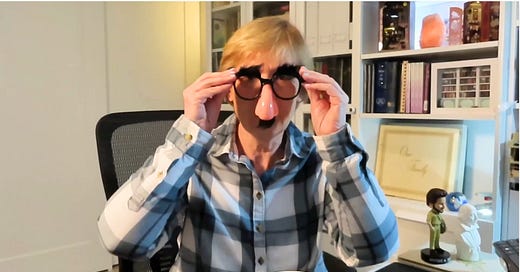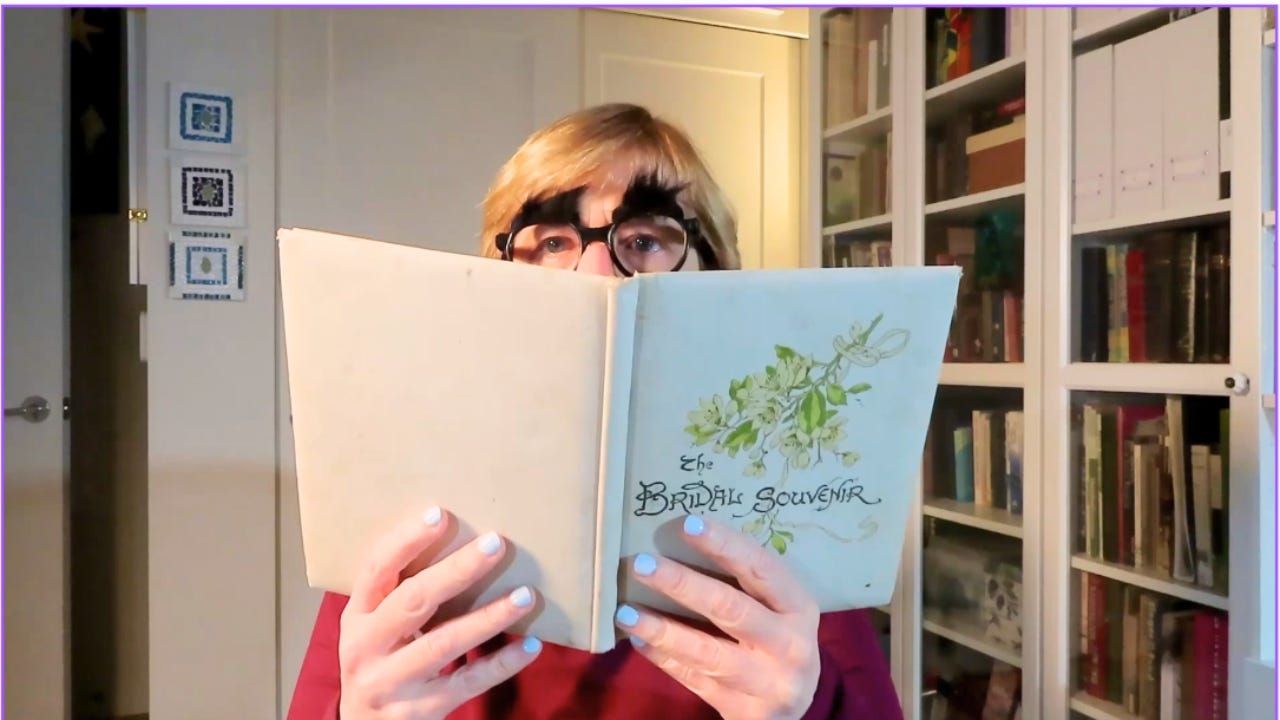The Easter Egg Hunt for Cousin Carol
Remembering family with mysteries, fugitives, and a hidden surprise.
It's March. Daylight savings time is back. It stopped raining for at least 10 minutes today. And my cousin's birthday is right around the corner.
How do you remember a cousin on her birthday week, just 11 months after she left us for wherever good cousins go next?
We're past the shocky stuff. We don't need tears or maudlin memories. I'm thinking something closer to a wink. A nod. Maybe ... an Easter Egg?
Not those expensive chicken eggs that are so hard to find at the store. What is going on with egg prices, anyway? First they said it was Covid. Then they said, oh, it's avian flu.
What next? I smell a conspiracy.
The only thing my family loves more than a good conspiracy is a good bargain. I'm not sure if we got the bargain bug from Grace, Elmer, or both. Grace and Elmer Olson are my grandparents. They had 14 grandchildren. We lost one cousin early. Each generation has this struggle. Grace and Elmer lost two children: Fred near birth, and little Johnny when he was 14 months old. Grace's parents lost young John at age 3. Based on this, I refused to use the name "John" for any of my children. It just felt unlucky.
But I digress. Back to the eggs.
There's a type of Easter Egg that doesn't come from chickens. It's a hidden message, often in software, included as a joke or bonus. So I sat down to make a video with this Easter Egg in mind. Could I embed one, as a quiet nod to our lost cousin on her birthday? Something gentle, humorous, that she would get if she were here?
At her wedding, when it was time for the kiss, Cousin Carol and her new husband turned their backs to the audience, donned some silly glasses with fake noses and mustaches, then turned back around for the kiss. It was corny and fun. The wedding crowd cheered.
At her memorial service, our entire family put on similar glasses and turned around to face the rest of the congregation. Yes, Cousin Carol, an entire church full of people burst into laughter at your memorial service. You would have loved that.
So I decided to find a way to get those glasses into my video. Viola'. Easter Egg.
The glasses in the video aren’t just a joke. They’re a way of saying, We remember. We celebrate. We love. And we find ways to laugh, even in the face of loss.
Thirteen grandkids outlived my grandparents, but the 2020's have not been kind to us. First we lost Ron, then Carol, and a few months later, Pam.
When we lost that first little cousin years ago, it was a sudden shock, a one-off accident. But this recent thing where we lose one after another, and then another? It's a different deal. It's stealthy. It's relentless. It nags at the edges of our thoughts until one day we realize, holy bleeping sheep, we're the Old Folks now.
There's an interesting responsibility that comes with being one of the Old Folks. You need to help the younger generations learn to say good-bye with love and humor. In our family we try to do that by telling stories, poking fun at ourselves, and, maybe, with the occasional Easter Egg.
So this week, as I sift through photos, stories, and AI-generated reports, there's also just a little something extra—a hidden wink in the video, just for Carol. Because that's how we say, "We remember you."
But wait, there's just one catch. How will I even get my family to watch this? I'm competing with Tik Tok, Miss Rachel, and Spring Break!
Yes, some will watch out of loyalty. But there is no better time to learn to advertise than with your own family. My family loves puzzles and mysteries. So I can work with that.
Perhaps I should start with a different text to each of the older grandchildren. "10 brownie points for you if you can tell me the answer to this mystery: What year was the corn flakes photo taken?" And for my grandson: “Do you think this is real, or AI?”
For adult cousins? I could ask something like: “What book am I hiding behind?” Because the next generation may not realize that this is Grandma's wedding book. Grace and Elmer met at the home of Carl Rasmussen in April 1913. I know, because she says so, right here, in her pretty handwriting, which I would be happy to show them, if they ask …
I wish we could have met Grandma. I loved Gramps, but I have a sneaking suspicion he was a lot less gruff when she was around. Maybe Carol and Ron and Pam are somewhere with her now. And with Gramps. Gruff old Gramps.
I have never been up to the old ranch where they first lived in South Dakota. Perhaps I'll get there someday. But Spearfish, Deadwood, Belle Fourche, all those areas in the Black Hills just south of the ranch? Beautiful! If you ever get a chance to visit, go!
Here's the story, slightly late, for 52 Ancestors in 52 weeks, week 10: Siblings.
Some quick notes about the video:
All photos are family photos except the video of the McGuffin boys, which was created from a photo but turned into a video by Kling AI. (Shown above.)
ChatGPT can be accessed via voice or text. I used both, interchangeably, depending on what I was doing. The voice in the video was generated by ElevenLabs, but the words themselves all came from ChatGPT.
I am a big fan of some of the pre-defined GPTs in ChatGPT that are created by Steve Little and Mark Thompson. They make this tool much easier to use.
See Mark's website here: https://makingfamilyhistory.com
Steve's blog here: https://aigenealogyinsights.com/blog/
Both places have links to their joint podcast.
GPTs are pre-written sets of instructions within ChatGPT. In the video I used Mark Thompsons Historical Photo Analyzer GPT.
Log in to ChatGPT and search for this using the Explore GPTs option.
Upload your photo. Let it tell you its base information, then if you want, ask additional questions.
ChatGPT can provide interesting and useful feedback, and it can sometimes draw some very bizarre and incorrect conclusions, so I treat it just like an opinion from a person. You'll see me doing that in the video. I always question it. I never assume it's correct.
Here's what's cool about Mark Thompson's Historical Photo Analyzer. He has it all set up to analyze the photo in a nice little table. Here's an example: (Note how it thinks Great Grandma is not wearing shoes ; )
I also use the new ChatGPT Deep Research functionality in the video to get a report on Sheep Ranching in South Dakota homesteads in the 1900-1920 time frame. Here’s the report: https://chatgpt.com/share/67d24f72-a464-8002-824d-a8887d376a1b. See this article by Mark Humphries for more information on Deep Research. (I am still figuring out how to use it. I would say right now I’m not a pro!)
Since I'm not a trained researcher, I'm not qualified to grade these against high quality research reports. It appears to me that they show some promise as starting points for secondary sources that aren't behind paywalls, and they provide links to further information that might have been hard for me to find on my own. (In particular I noticed links to places within Internet Archives and newspaper sites like Chronicling America.) I found it particularly interesting that sheep ranching became much less financially viable at the end of World War 1. I'm not certain if that's when my Olson Great Grandparents found themselves in financial difficulty or not. I know that at some point sheep ranching became a problem for them. The report points to both weather and war trends that might help me understand their situation better.
Until next time, happy hunting. Go find some family stories.







I do like Mark Thompson's approach to analyzing photo detail. Fascinating and a terrific use for GPTs as it inspires more ideas as a coach or partner would. Fantastic.
That was fun! If I were more of a detective, I might have thought to search based on the corn flakes history myself, but it was useful for ChatGPT to point that out for me. It was also very useful for me to keep digging beyond what it pointed out, to go find more granular information beyond it's initial analysis.